|
 Gloiocephala phormiorum Gloiocephala phormiorum
BiostatusPresent in region - Indigenous. Endemic
Images (click to enlarge)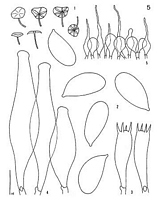
Caption: Gloiocephala phormiorum Horak & Desjardin (PDD, holotype): I, basidiomes (x2);
2, basidiospores (x2000); 3, basidia (x1000);
4, hymenial cystidia (cheilo- and pleurocystidia, x1000); 5, pileipellis with
pilocystidia (x500). | 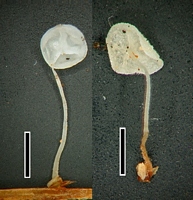
Caption: scale=2mm
Owner: J.A. Cooper | 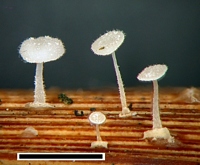
Caption: scale=2mm
Owner: J.A. Cooper | 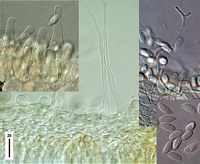
Caption: top left cheilocystidia, middle pilocystidia, top right caulocystidia, bottom right spores.
Owner: J.A. Cooper | 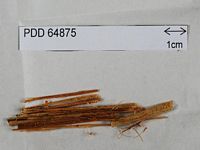
Caption: Dried type specimen
Owner: Herb PDD |
Article: Horak, E.; Desjardin, D.E. (1994). Reduced marasmioid and mycenoid agarics from Australasia. Australian Systematic Botany 7: 153-170.
Description: Pileus 2-7 mm diam., at first convex,
soon becoming plane or depressed at centre with up turned margin, white, cream
or pale yellow, pruinose to velvety (minutely hairy-strigose under hand-lens),
indistinctly sulcate towards margin, gelatinous in fresh condition (pileipellis
separable). Lamellae 2-6, venose to fold-like, attached to apex of stipe, occasionally
hymenophore smooth, cream, edges concolorous. Stipe 3-7 X up to I mm, always
central, cylindric, equal, whitish to cream, minutely pruinose overall, dry,
solid, solitary in groups, insititious (basal disc or byssus absent). Basidiospores
16-19 X 8-9.5 µm, broadly elliptic, slightly inequilateral in profile, smooth,
hyaline, inamyloid. Basidia 40-45 X 11-15 µm, tetrasporic, subcylindric to clavate,
sterigmata up to 9 µm long, clamped. Cheilo- and pleuro-cystidia numerous, 60-115
X 20-30 µm, fusiform to lageniform, apex rounded or indistinctly capitate, thin-walled,
smooth, hyaline. Pileipellis hymeniform, composed of vesiculose to clavate smooth
cells 20-30 X 10-20 µm, subgelatinous, hyaline, thin-walled. Pilocystidia numerous,
40-85 X 8-12 µm, fusiform with long, gradually tapering neck, apex rounded or
sub acute, thin-walled, hyaline. Oleiferous hyphae absent. Stipe tissue monomitic.
Stipe cortical hyphae cylindric, 5-10 pm diam., smooth, thin-walled. Caulocystidia
numerous. 20-110 X 3-7 µm, trichiform or subfusiform with gradually tapering
apex, tips rounded or pointed, thin-walled, hyaline.
Habitat: On rotting leaves of Phormium tenax
J.R. & G. Forst. (Phormiaceae). Known from South Island of New Zealand.
Notes: Gloiocephala phormiorum belongs in sect. Gloiocephala subsect. Macrosporae Singer (1976) where
its closest ally appears to be G. longispenna Singer (from Brazil: Singer
1976). The New Zealand taxon is distinguished by relatively large basidiomes
with 2-6 fold-like lamellae and a well-developed, white, central stipe: broad
basidiospores (8-9.5 µm diam.); fusiform to lageniform, thin-walled hymenial
cystidia 60-110 µm long, and fusiform-rostrate pilocystidia 40-85 µm long. In
comparison, G. longisperma forms small basidiomes with a more reduced
hymenophore and black stipe base, narrower basidiospores (3-4 µm), ventricose
hymenial cystidia 30-40 µm long, and pilocystidia 100-200 µm long (fide Singer
1976). The present new species differs from others in the subsection by lacking
metuloid hymenial cystidia, having much larger basidiospores, and in its fructification
on Phormiaceae.
|